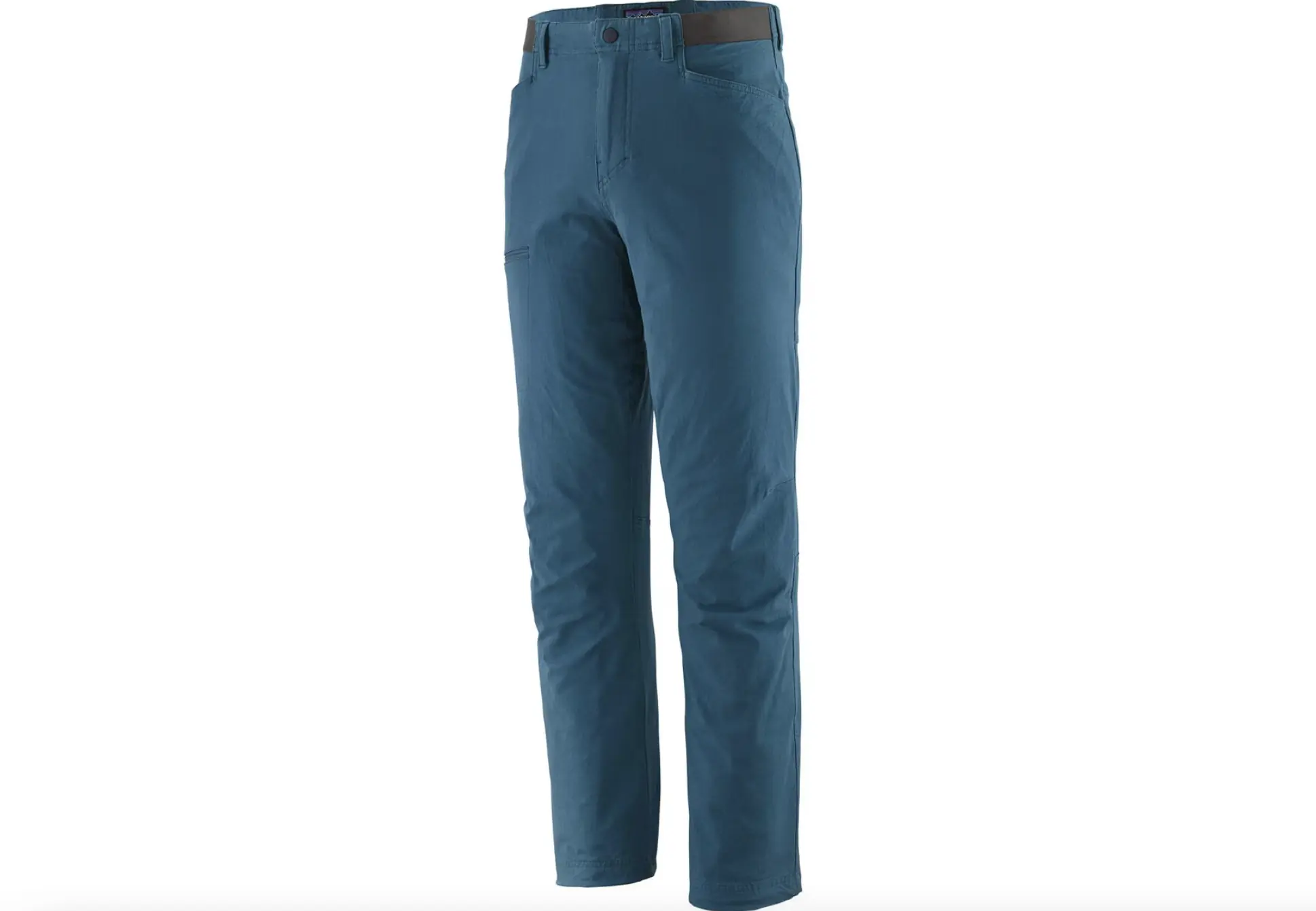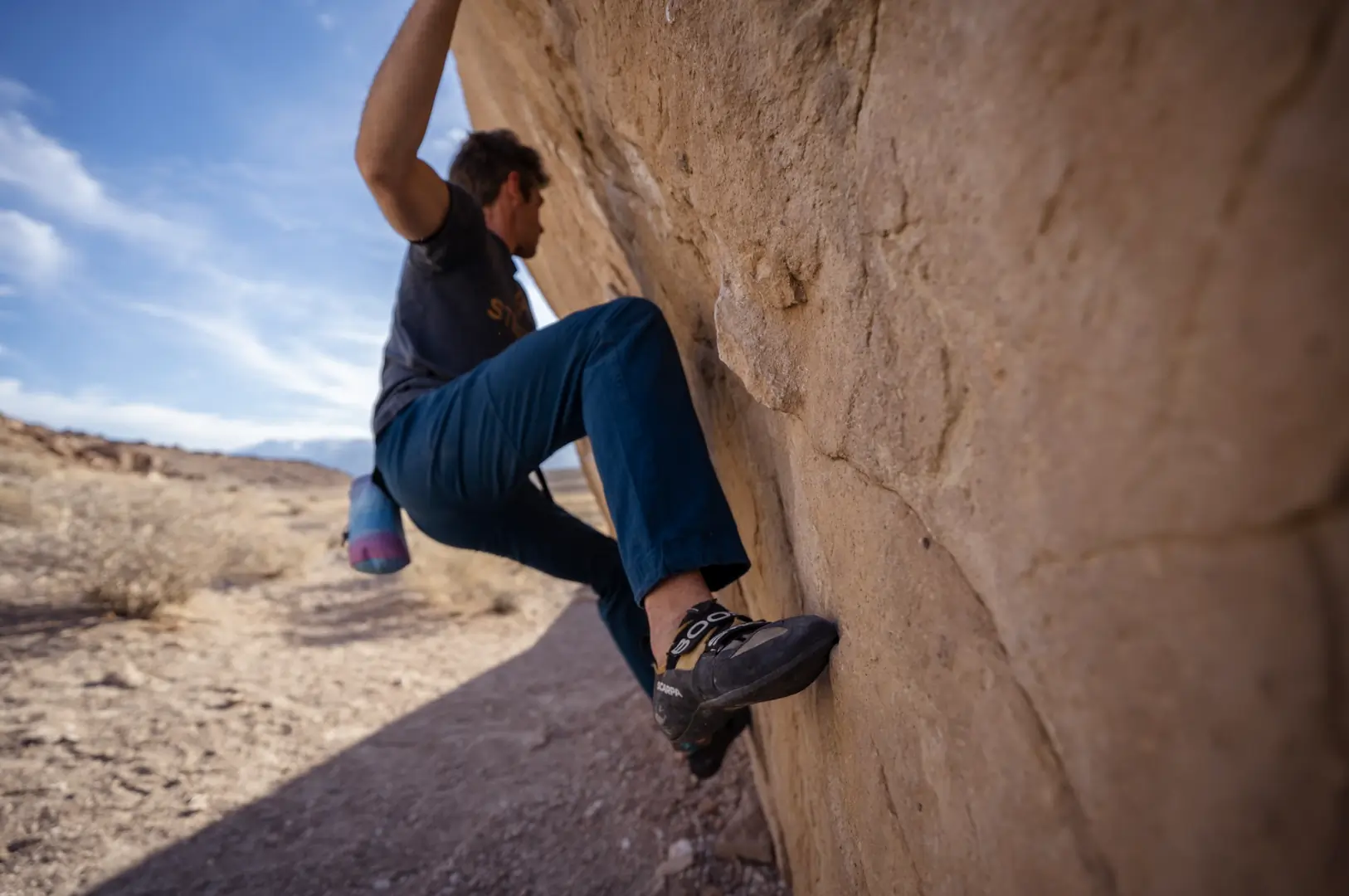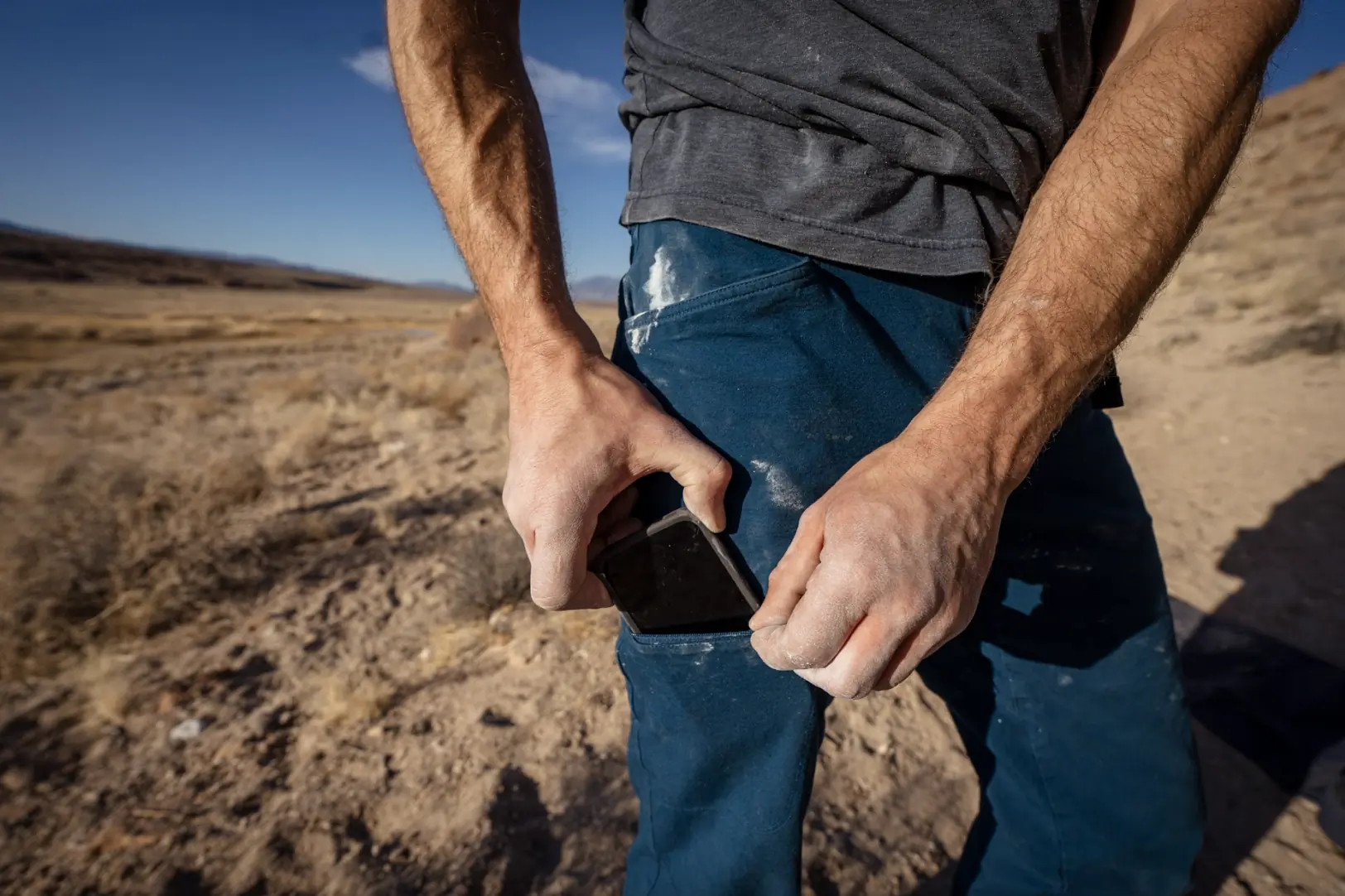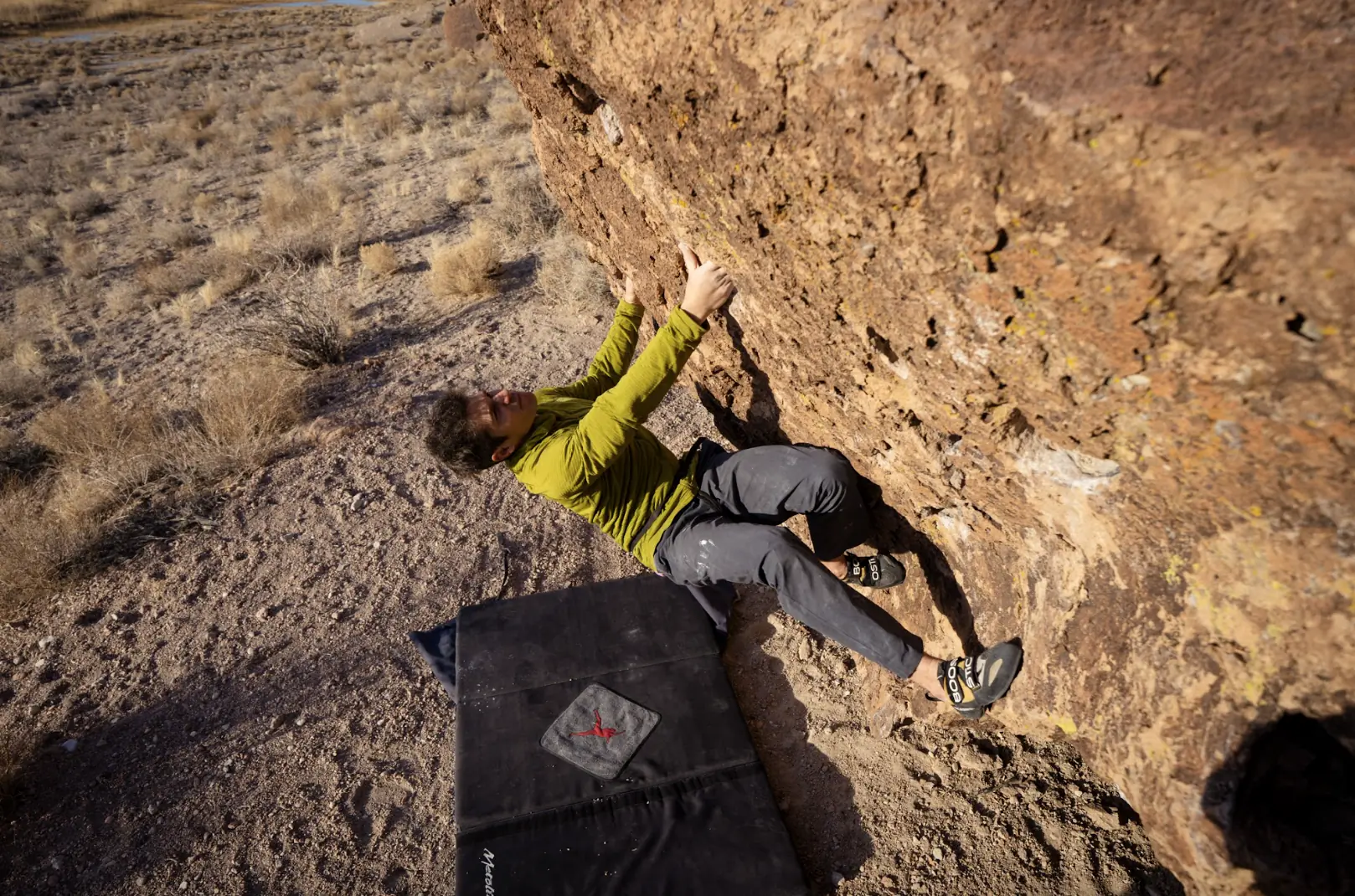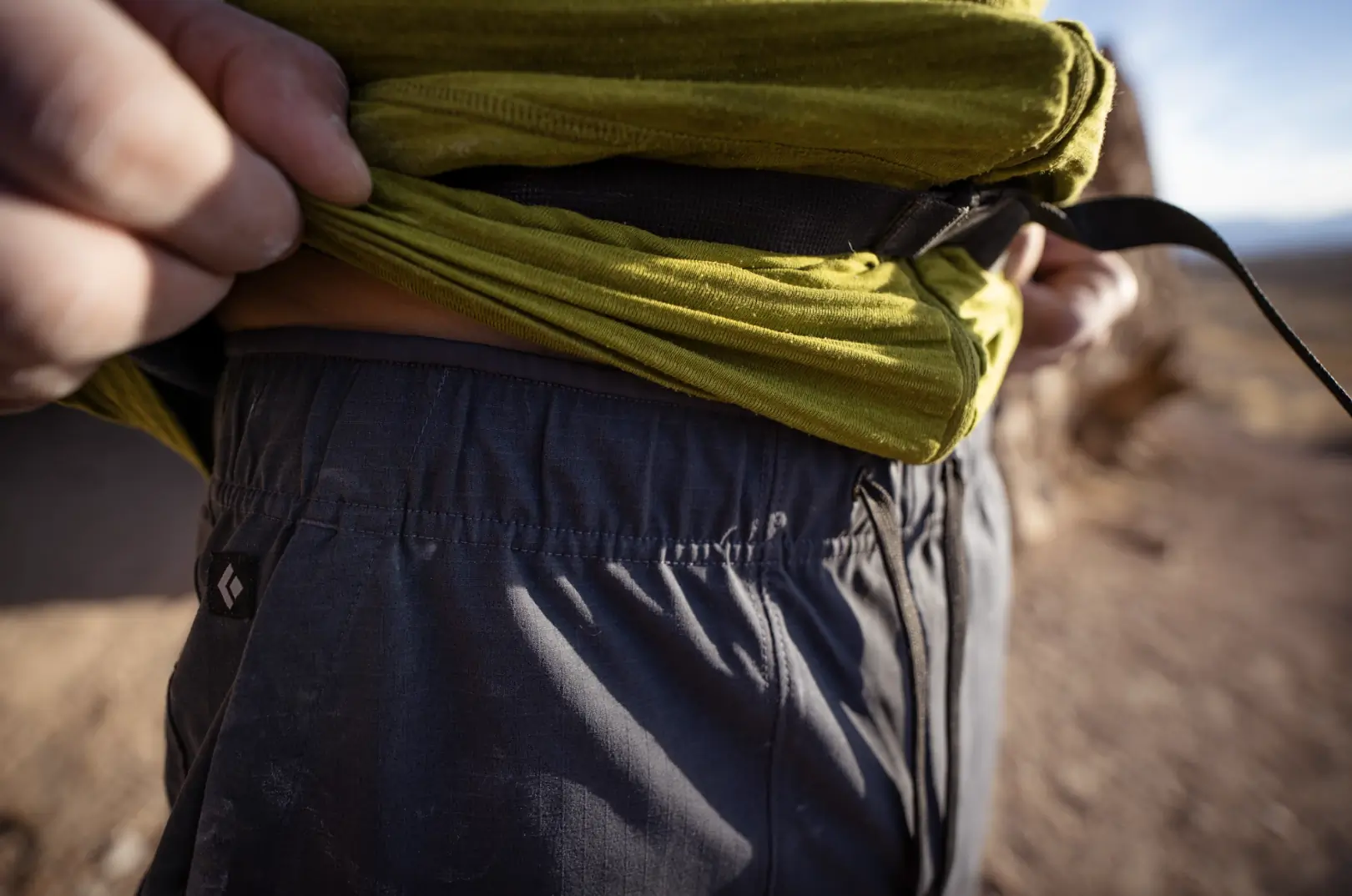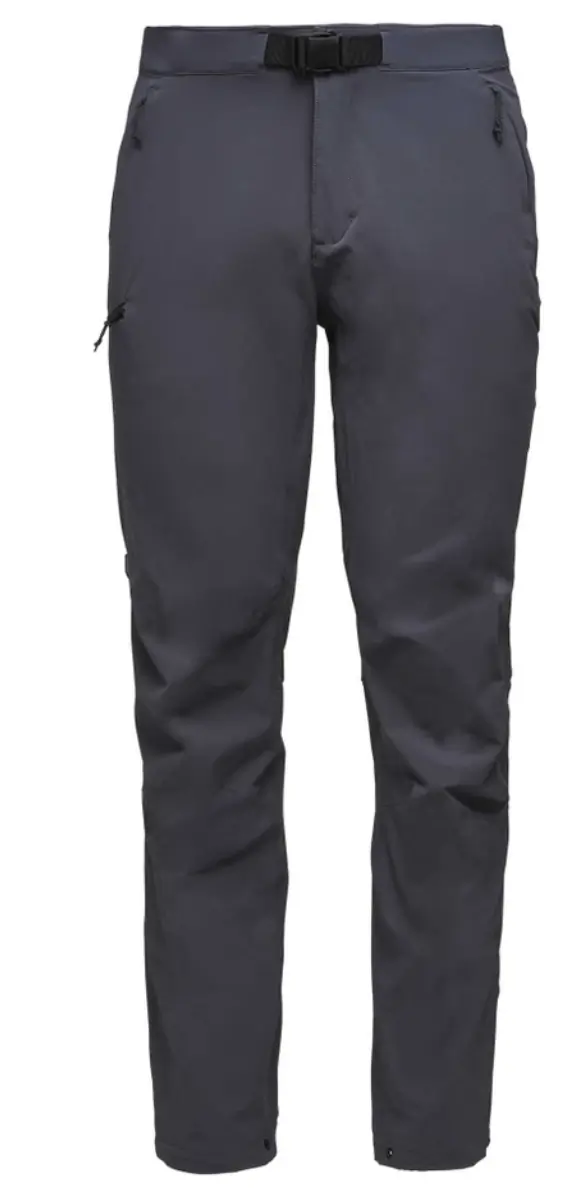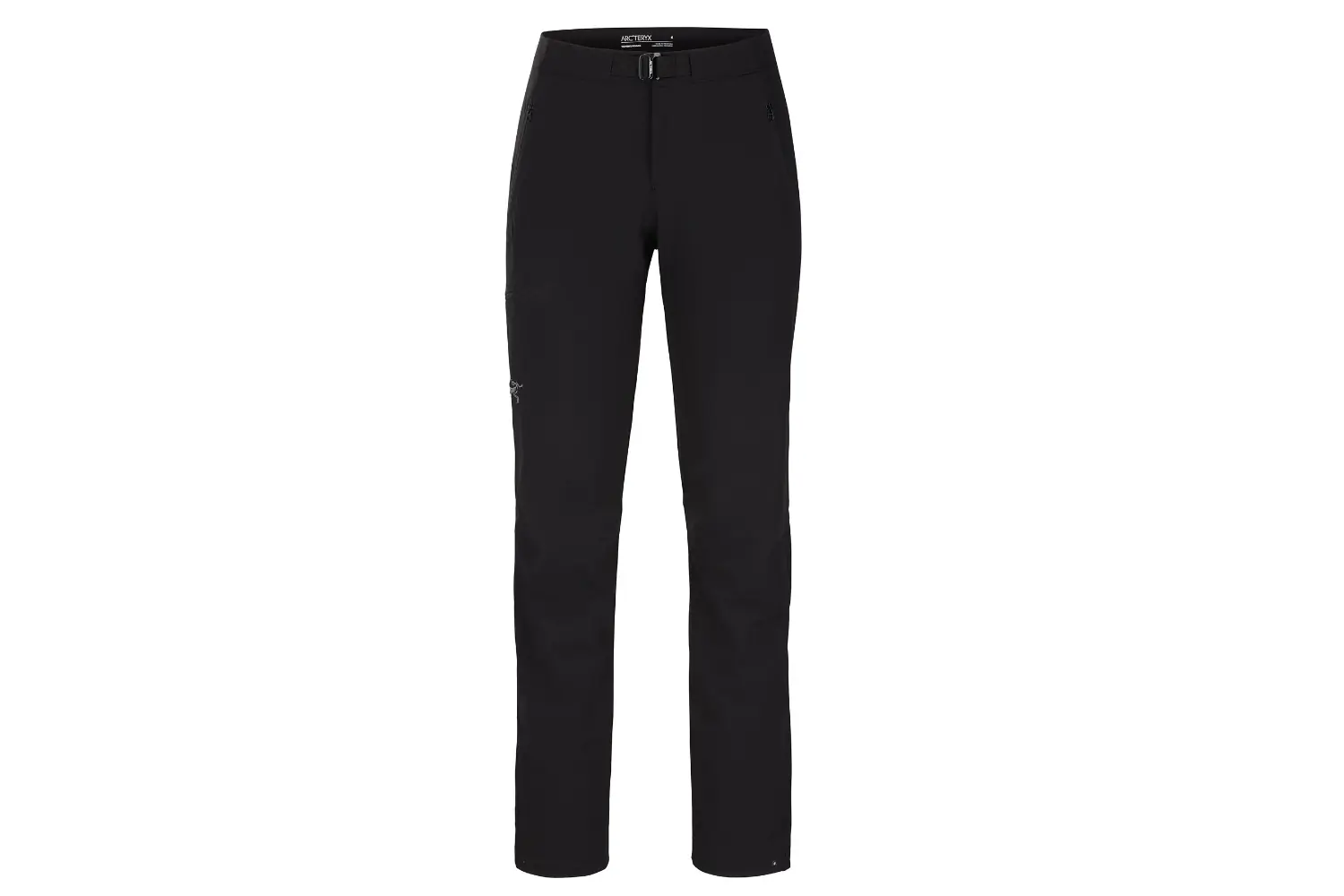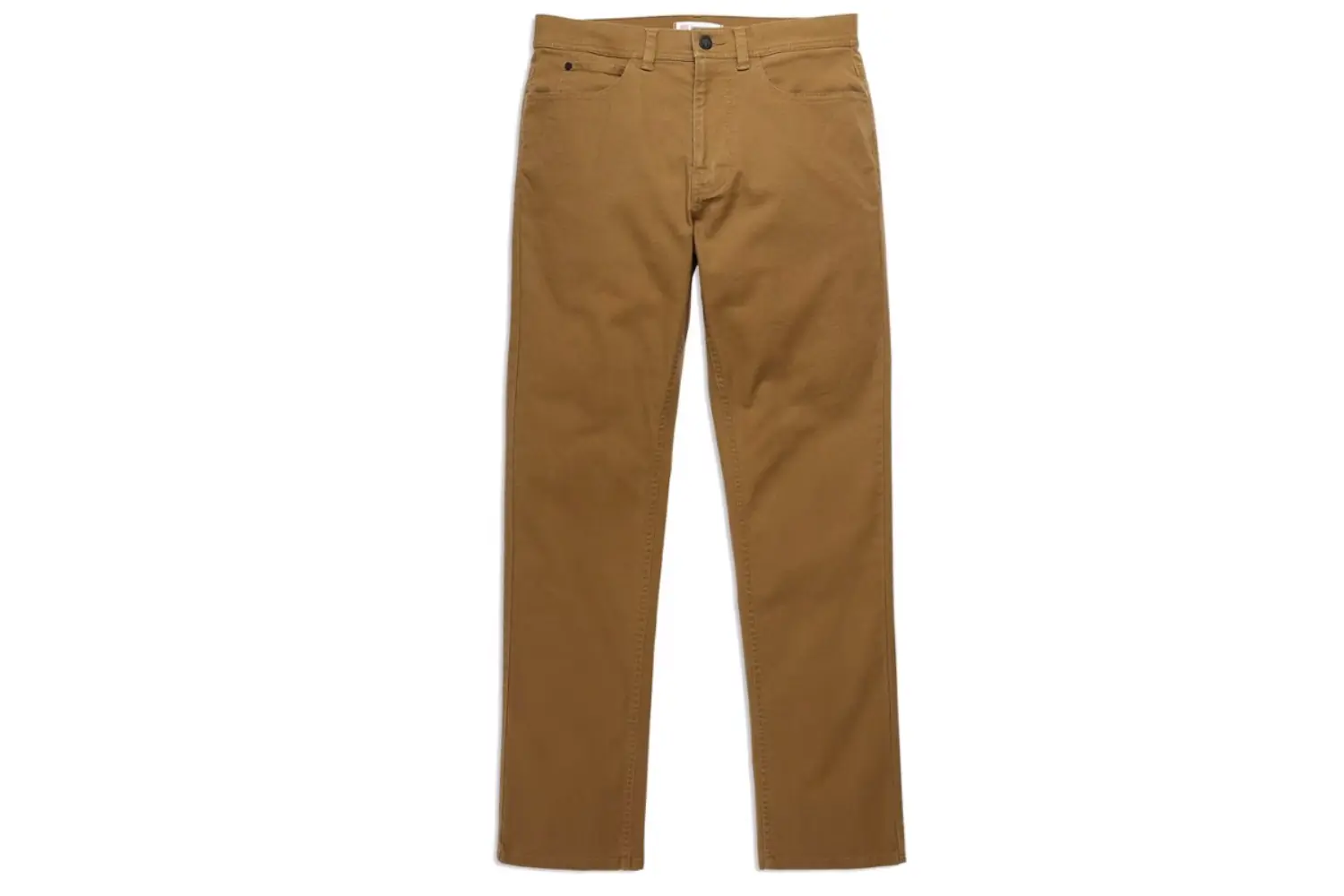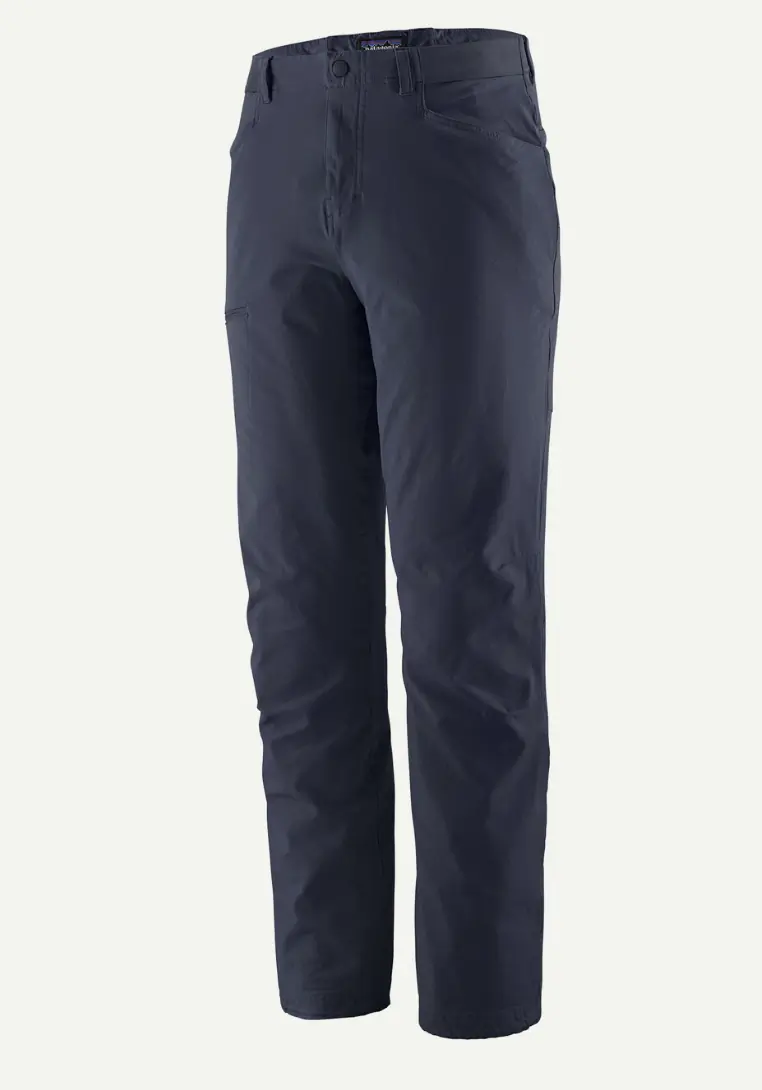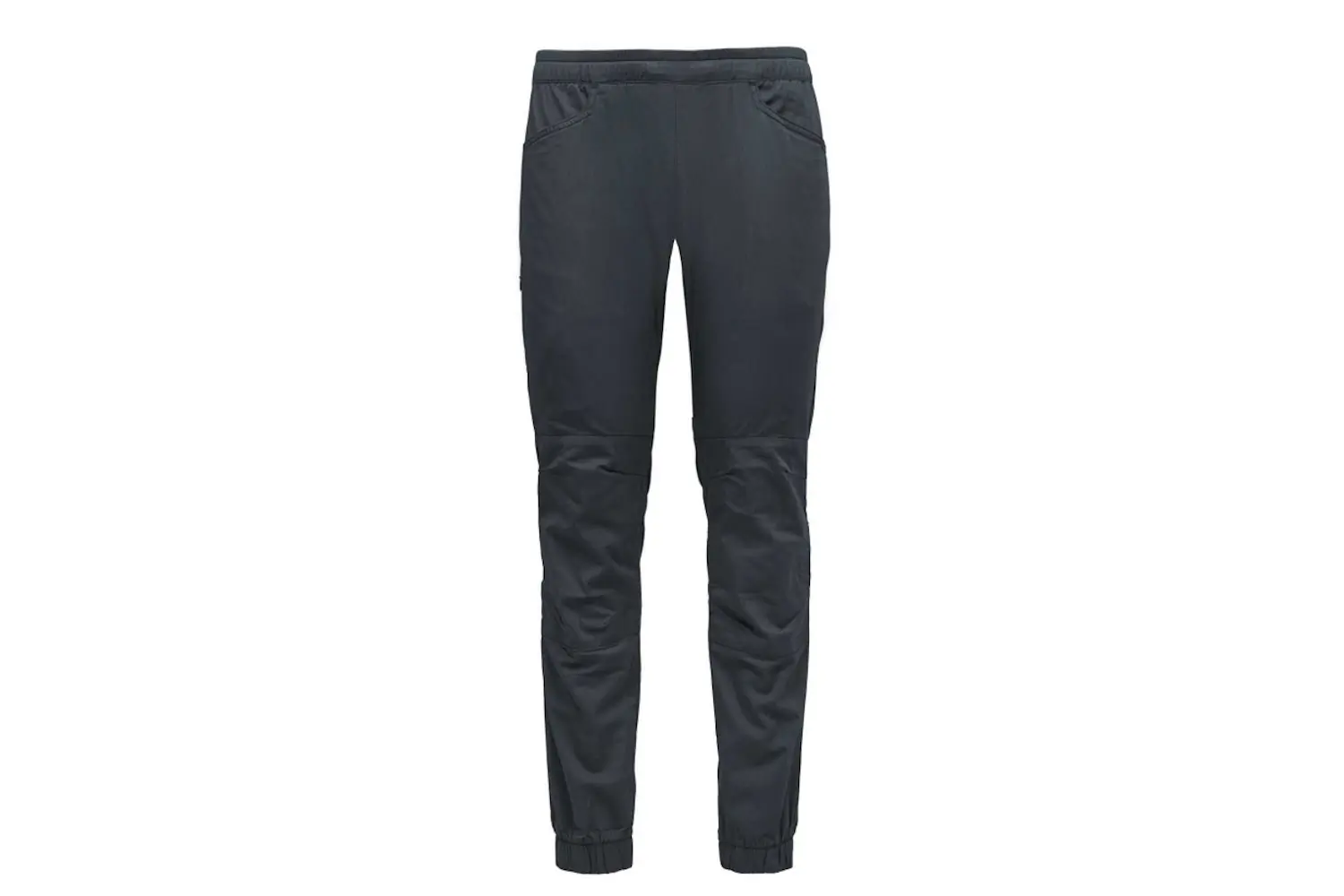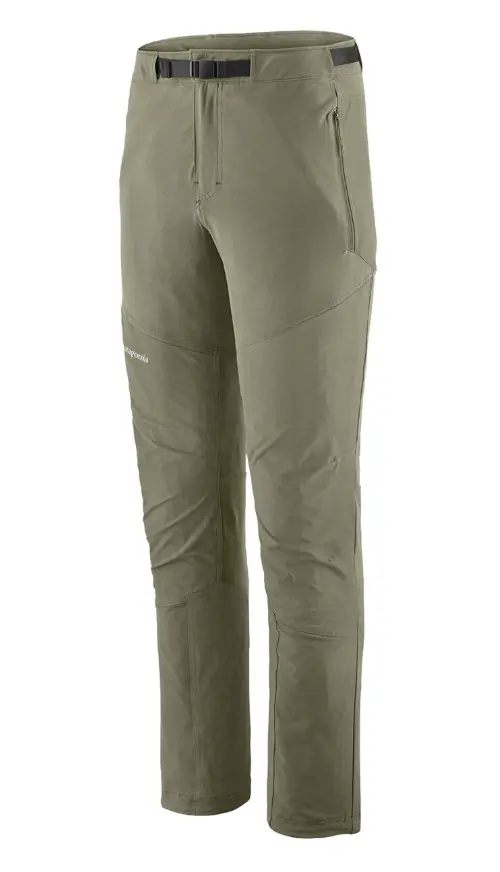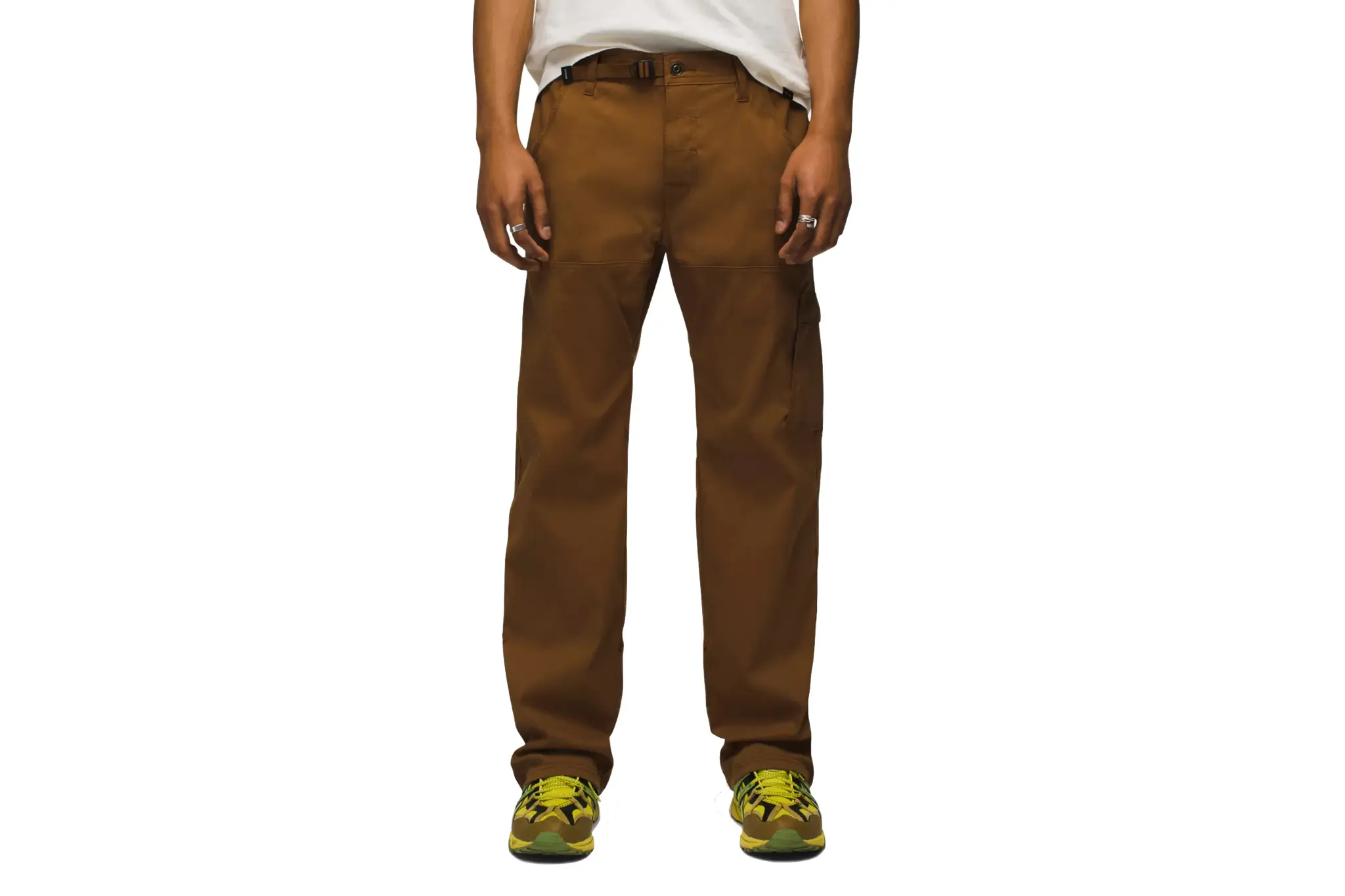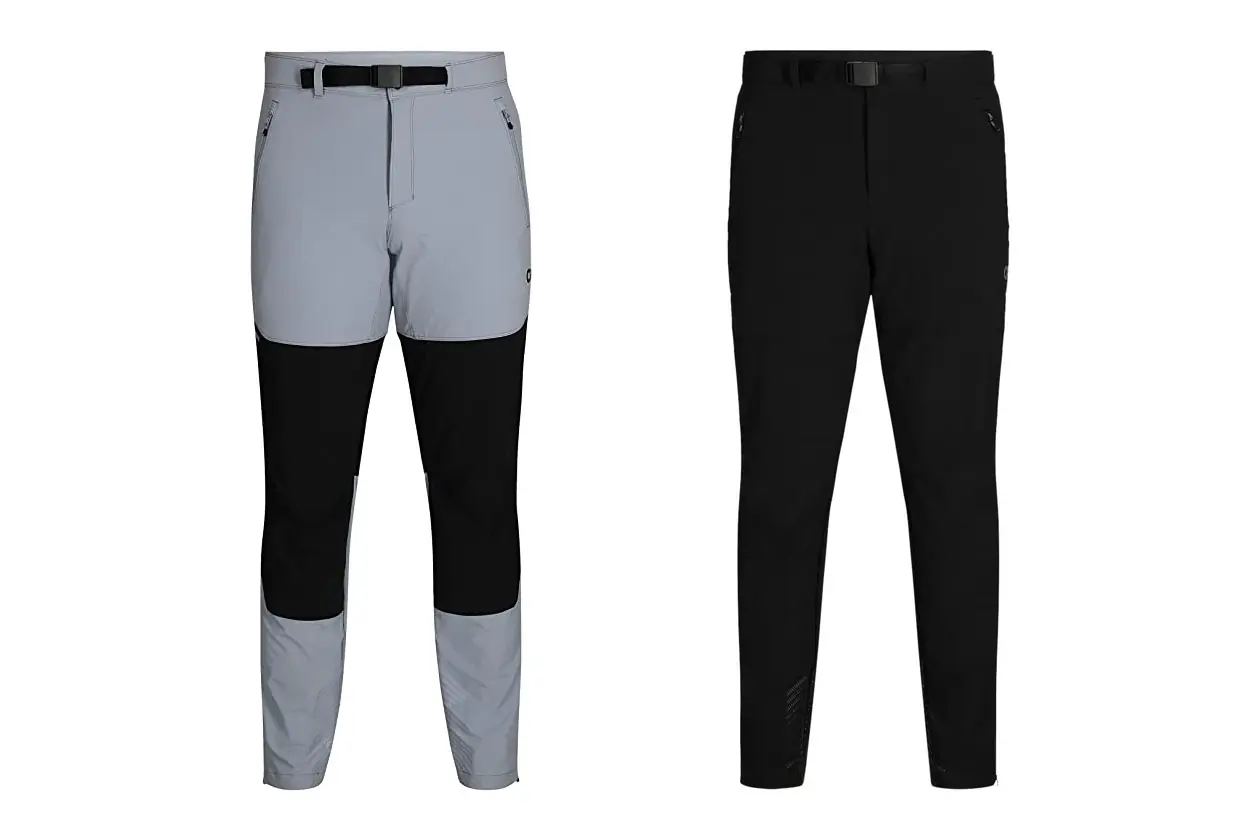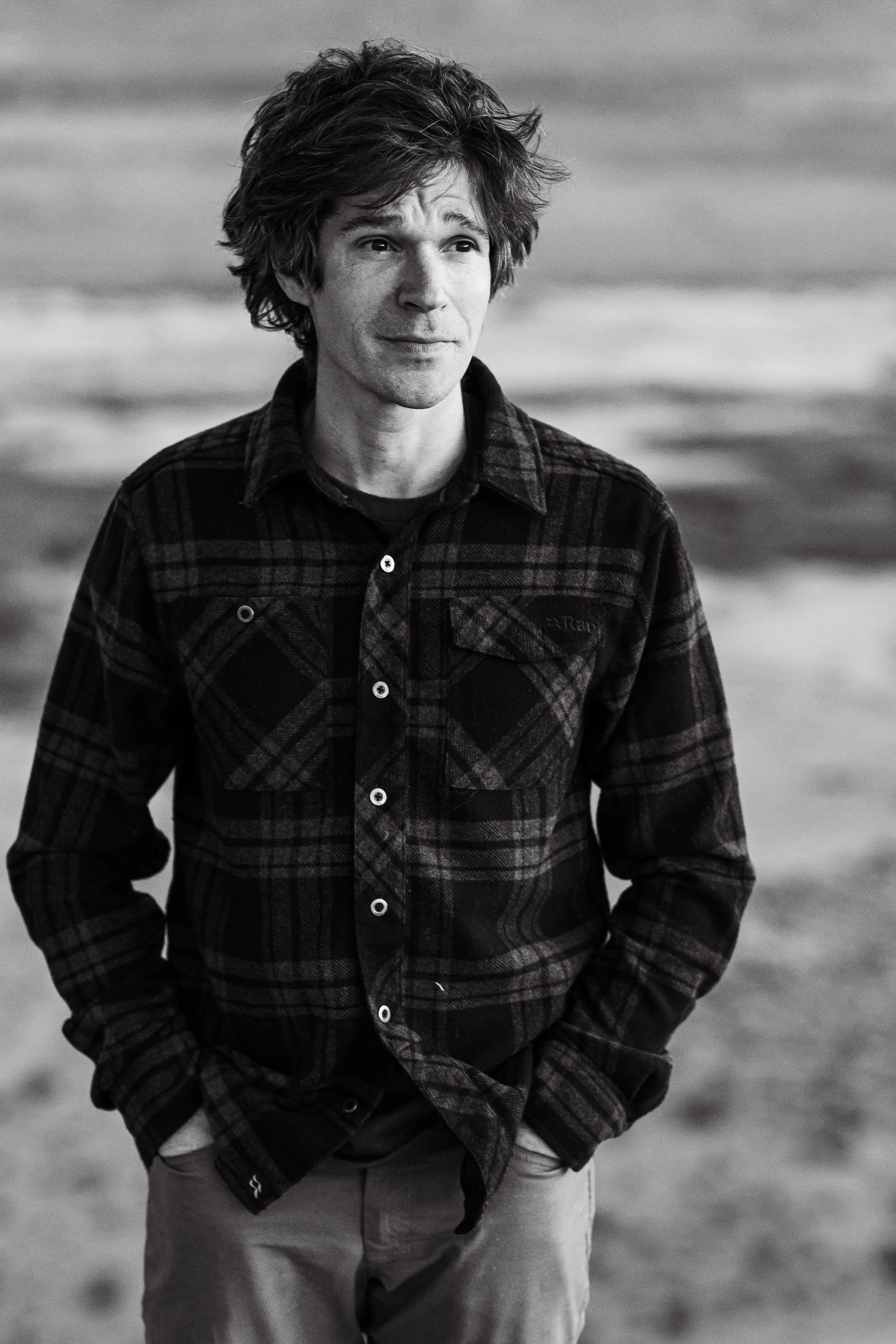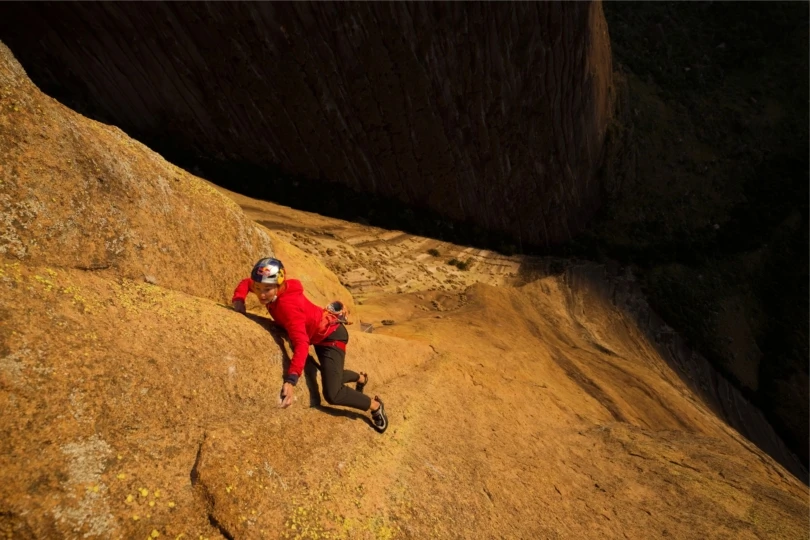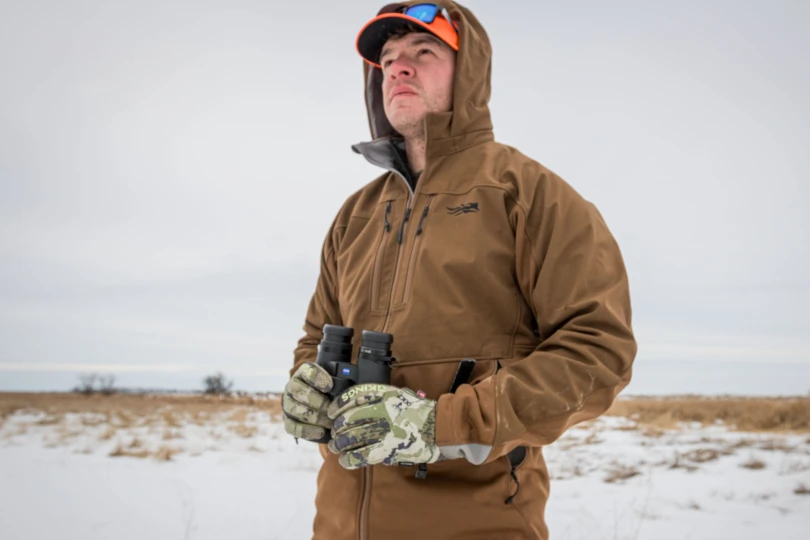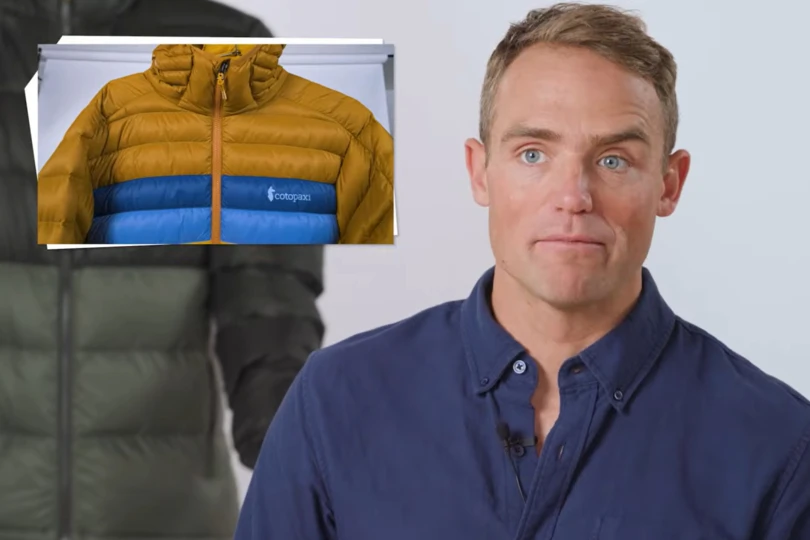Whether you’re training in the gym or planning your next multi-pitch adventure, we’ve identified the best climbing pants for every budget and adventure.
Climbing pants are designed with careful consideration of everything climbers need. Solving boulder problems, tackling grueling alpine routes, and redpointing single-pitch sport routes all require capable and durable clothing.
Apparel-related discomfort can limit performance, so climbing pants should offer freedom of movement, protection from the elements, comfort, and thoughtful features. The Patagonia Venga Rock Pants are our current favorites, and the Mountain Hardwear Basin Pull-On Pants are the way to go if you’re on a budget.
Admittedly, we’ve had a lot of fun putting these trousers to the test. Austin Beck-Doss, a man with long legs and steel fingers, evaluates each pair while contorting his way up the steep limestone around Lander, Wyoming, where mobility is key, and summer storms offer plenty of opportunity to test the weather resistance and drying properties of each pair.
Further west, senior editor Matt Bento puts climbing pants through their paces in Bishop, Calif. The sharp, grainy rock of the Buttermilks is a 10-minute drive away, and another 10 minutes puts him at 10,000 feet, where he can ramble and scramble over the endless ridges of the High Sierra. Since 2021, they’ve tested over 20 pairs of the best pants from top brands and notable smaller manufacturers to inform this guide.
Editor’s Note: Freshly updated on May 13, 2025, this guide now includes the lightweight Patagonia Terravia Alpine pants.
The Best Climbing Pants of 2025
Patagonia Venga Rock Pants
- Weight: 14.7 oz.
- Material: 93% Regenerative Organic Certified cotton/7% spandex plain weave with four-way stretch
- Number of Pockets: 5
- Special Features: Stretchy waistband, adjustable cuffs, gusseted crotch, articulated knees
- Fit: Regular straight fit, pretty true to size
Pros
- Super comfy
- Durable
- Zippered thigh pocket
- Doesn’t restrict mobility in any way
Cons
- Cotton-poly blend won’t do for the alpine
- Waistband is a little too stretchy, you’ll want a belt
Mountain Hardwear Basin Pull-On Pants
- Weight: 9.5 oz.
- Material: 94% nylon, 6% elastane, PFC-free DWR finish
- Number of pockets: Two front hand pockets, two drop-in back (including one zippered)
- Special features: Elastic waistband, zippered back pocket, drawstring waist
- Fit: Roomy
Pros
- Comfortable
- Roomy fit
- Zippered rear pocket
- Durable elastic waistband
Cons
- Rear zippered pocket is difficult to access with a harness on
Black Diamond Sequence Pants
- Weight: 10.9 oz.
- Material: Polyester Stretch Rip Stop with PFC-Free DWR
- Number of Pockets: 4
- Special Features: Drawstring, back pockets have snap closure
- Fit: Regular straight fit, slightly high-waisted
Pros
- Stretchy
- Light but durable
- Athleisure styling
Cons
- No fly is inconvenient when wearing a harness
- All-synthetic material can start to smell after many days of continuous wear
Black Diamond Alpine Pants
- Weight: 14.1 oz.
- Material: Four-way stretch-woven with PFC-Free DWR finish
- Number of pockets: 3 (2 zippered hand pockets, 1 zippered side pocket)
- Special features: Webbing Belt, adjustable hems
- Fit: Slim
Pros
- Great stretch
- Lightweight for summer missions
- Zippered pockets
- Low-profile belt
Cons
- Could be a little tight for big mountaineer’s legs
- They’re techy. If you wear them to the bar, you might look like a dork
Arc’teryx Gamma Pants
- Weight: 12.5 oz.
- Material: 88% nylon, 12% elastane
- Number of pockets: Two zippered hand pockets, one zippered thigh pocket
- Special features: Zippered thigh pocket, adjustable cuffs, integrated waistbelt
- Fit: Regular fit with straight legs
Pros
- Great warmth-to-weight ratio
- Suitable for cold weather climbing
- Durable
- Secure pockets
Cons
- Expensive
Topo Designs Dirt 5-Pocket Pants
- Weight: Unknown
- Material: 98% organic cotton, 2% spandex
- Number of pockets: Three front pockets, two rear pockets (one hidden zippered pocket)
- Special features: Crag to town look
- Fit: Straight, slim
Pros
- Burly work-wear inspired material
- Hidden zippered pocket locks down things like keys
- Just the right amount of stretch
Cons
- No thigh pocket for harness access
- Lacking cinchable cuffs
Coalatree Decaf Denim
- Weight: 1 lb.
- Material: 89% cotton, 9% "Ice Cafe Nylon" (make from recycled coffee and plastic), 2% spandex
- Number of pockets: Two front pockets, two rear (including one zippered)
- Special features: Hidden zip rear pocket, anti microbial
- Fit: Slim
Pros
- Stretchy
- Breathable
- Nice looking
Cons
- Lacks a gusseted crotch
More Climbing Pants, Field-Tested
The following pants didn’t receive our top accolades, but they’re still worth checking out.
- Weight: 11.3 oz.
- Material: 53% organic hemp/44% recycled polyester/3% spandex plain weave
- Number of Pockets: 4
- Special Features: Gusseted crotch, articulated knees, Unique hemp-poly blend
- Fit: Straight fit, slightly baggy
Pros
- Pajama-like comfort
- Very breathable
- Slightly stretchy
- Great fit for climbing
Cons
- Not durable enough for traditional climbing
- Absorbs water, takes more time to dry
- Weight: 14.5 oz.
- Materials: 98% organic cotton, 2% elastane
- Number of pockets: Two front pockets, two rear
- Special features: Reinforced knees, elastic waistband with adjustable drawstring
- Fit: Standard, jogger
Pros
- Comfortable
- Perfect for bouldering
- Unrestricted mobility
Cons
- No zippered phone pocket
- Weight: 12.2 oz.
- Material: 4.7-oz 86% recycled polyester/14% recycled spandex
- Number of Pockets: 4
- Special Features: Built in belt, reinforced panels
- Fit: Form fitting, true to size
Pros
- Light and breathable
- Well designed built-in belt
- Zippered pockets
- Reinforced panels match the rest of the pants
Cons
- Not good for snowy, inclement wether
- Material over thigh pocket is thin, quick to wear through
- Weight: 13.2 oz.
- Material: Stretch Zion — 97% nylon, 3% elastane
- Number of pockets: Two front hand pockets, two rear, one zippered thigh
- Special features: Roll up pant leg snaps, webbing waist belt, rear pocket flap, vent holes in gusset
- Fit: Relaxed; straight leg
Pros
- Original Stretch Zion material has perfect blend of give and durability
- Wide size range available
- PFAS-free DWR finish
- Roomy fit doesn't constrict motion
Cons
- Pants will pill eventually with enough climbing
- Weight: 13.6 oz.
- Material: 88% nylon, 12% spandex
- Number of pockets: Two zippered front pockets, zippered thigh pocket
- Special features: Crotch gusset, integrated belt, elastic cuffs, reinforced scuff guards
- Fit: Standard
Pros
- Stretchy
- Plentiful zippered pockets
- Versatile
Cons
- Not ideal for hot conditions
Men’s Climbing Pants Comparison Chart
| Men’s Climbing Pants | Price | Weight | Material | Pockets | Fit |
|---|---|---|---|---|---|
| Patagonia Venga Rock Pants | $109 | 14.7 oz. | Material: 93% Regenerative Organic Certified cotton/7% spandex plain weave with four-way stretch | 2 front pockets, 2 back pockets, 1 zippered thigh pocket | Regular straight fit, pretty true to size |
| Mountain Hardwear Basin Pull-On Pants | $79 | 9.5 oz. | 94% nylon, 6% elastane with PFC-free DWR finish | 2 front hand pockets, two drop-in back (including one zippered) | Roomy |
| Black Diamond Sequence Pants | $95 | 10.9 oz. | Polyester Stretch Rip Stop with PFC-Free DWR | 2 front hand pockets, 2 back pockets w/ snap closure | Regular straight fit, slightly high-waisted |
| Black Diamond Alpine Pants | $150 | 14.1 oz. | Four-way stretch-woven with PFC-Free DWR finish | 2 zippered hand pockets, 1 zippered side pocket | Slim |
| Arc’teryx Gamma Pants | $200 | 12.5 oz. | 88% nylon, 12% elastane | 2 zippered hand pockets, one zippered thigh pocket | Standard; straight legs |
| Black Diamond Notion | $95 | 14.5 oz. | 98% cotton, 2% elastane | 2 front pockets, two rear | Jogger |
| Topo Designs Dirt 5-Pocket Pants | $109 | Unavailable | 98% organic cotton, 2% elastane | 3 front pockets, two rear pockets (1 hidden zippered pocket) | Straight fit; slim |
| Coalatree Decaf Denim Jeans | $109 | 1 lb. | 89% cotton, 9% “Ice Cafe Nylon,” 2% spandex | 2 front pockets, two rear (including one zippered) | Slim |
| Patagonia Hampi Rock Pants | $99 | 11.3 oz. | 53% organic hemp/44% recycled polyester/3% spandex plain weave | 2 front pockets, 2 back pockets | Straight fit, slightly baggy |
| Patagonia Terravia Alpine Pants | $149 | 12.2 oz. | 4.7-oz 86% recycled polyester/14% recycled spandex | 2 front hand pockets, 1 rear, one zippered thigh | Form fitting, true to size |
| prAna Stretch Zion Pant | $95 | 13.2 oz. | Stretch Zion: 97% nylon, 3% elastane | 2 front hand pockets, 2 rear, one zippered thigh | Relaxed; straight leg |
| Outdoor Research Cirque Lite Pants | $139 | 13.6 oz. | 88% nylon, 12% spandex | 2 zippered front pockets, zippered thigh pocket | Standard |

How We Tested Climbing Pants
Our Testing Protocols
There are many disciplines of climbing, so not all climbing pants should have the same materials and technical specs. Bouldering pants need to be stretchy and durable, while alpine climbing pants need to be light and breathable.
With this in mind, we seek to highlight the best climbing pants for each discipline, with only apple-to-apples comparisons between similar designs. Cotton pants are comfortable and perfect for a day out in the boulders, but a poor choice for alpine missions with unstable weather. Likewise, you don’t want to look all teched out like you’re about to climb Mount Blanc for a casual bouldering session.
Each pair of pants is first evaluated in terms of fit. Are the pants generally loose or baggy? Do they restrict our movement at all? What mobility-enhancing design features are present? A gusseted crotch and articulated knees go a long way for both mobility and durability since you’re less likely to blow the stitching on pants designed to move with you.
Next, we move on to features. Are the pockets accessible with a harness on? Do they have zippers to secure chapstick and a few Gu’s while you charge up a multi-pitch? If the pants are treated with a durable water repellent, we run some water on them to see how well it actually works.
Finally (the fun part), we assess durability with quite a lot of climbing. Climbing pants are constantly subjected to abrasions as we bushwhack through thorns and stinging nettles, employ sneaky kneebars, and grovel up chimneys and offwidths. Highstepping and stemming put loads of stress on the stitching of an ill-fitting pair of pants, so if they’re not up to the task, we know quickly as the knees wear thin or the crotch blows out.
Our Testing Grounds
The majority of these pants are tested around the sport climbing paradise of Lander, WY, the bouldering hot spot of Bishop, Calif., and on the bigwalls of Yosemite, with some forrays into the High Sierra for good measure. The mountain towns offer quick access to different micro-climates at different elevations almost year-round, so our testers can experience sweltering heat and biting cold winds while evaluating climbing pants, sometimes on the same day.
The granite crucible of Yosemite chews up pants (and climbers) at an alarming rate. Climbing offwidths and jugging lines provide plenty of opportunity for abrasion testing. If one pair of pants can last a season in Yosemite, it’s probably worth owning a few!
Our Testing Team
Our main testers are Matt Bento and Austin Beck-Doss.
Matt Bento is the consummate climbing lifer, having lived out of a van for a decade (before it was cool), keeping his overhead low while spending winters in Spain sampling world-class limestone and working for Yosemite Search and Rescue in the summers in Tuolumne meadows. In those days, he wore a pair of ratty Dickies double-knee work pants because they lasted forever and could be purchased for an easy $20.
Durability is very important to Matt, and he’s always on the lookout for a bargain. Today, he’s semi-domesticated, living indoors in Bishop, Calif., where he has plenty of climbing out the front door, from bouldering to multi-pitch in the alpine.
Matt has been reviewing climbing and backpacking gear professionally for almost 10 years, using and abusing hundreds of products, enough to know what’s a gimmick and what works. As an editor at GearJunkie, he continues to evaluate and enjoy the latest gear and apparel to hit the market.
Writer and climber Austin Beck-Doss lives in Lander, Wyo. He puts his talent to work on steep limestone in Sinks Canyon and Wild Iris and ventures into the Wind River Range for a healthy dose of granite climbing. Austin is a certified single-pitch climbing instructor and has written about climbing and reviewed gear for over six years.
Buyer’s Guide: How to Choose Climbing Pants
Though you don’t strictly need climbing-specific pants to climb, they do have many clear advantages. Climbing pants offer helpful and specific features other activewear pants do not — including harness-compatible pockets and crampon-ready durability.
In this handy how-to-choose guide, we’ll cover all of the major considerations for selecting the perfect pair of climbing pants. This article focuses specifically on the best climbing pants for men. If you’re looking for women’s-specific options, check out our article on the Best Climbing Pants for Women.
Climbing Pants and Various Climbing Disciplines
Climbing is an umbrella term that covers many different sub-sports and disciplines. For example, alpine scrambling and indoor bouldering are very different activities. Ideally, your apparel and overall kit should always be tailored to match the demands of the specific activity at hand.

A pair of pants that’s great for one discipline of climbing may not be right for another. On this list, we’ve selected our favorite pair of climbing pants in many categories, including Best for Bouldering, Best for Alpine Climbing, and Most Durable.
Durability vs. Breathability
Climbing pants are guaranteed to make regular contact with rough and abrasive surfaces. For this reason, any pair of climbing pants worth its price tag will be abrasion-resistant and hardy.
In a climbing setting, durability is important. When you’re knee-jamming your way up a wide crack, you’ll want to know your pants won’t be completely shredded by the time you reach the anchor.
While durability is a priority for climbing pants, comfort, stretch, and breathability are important too. It’s not easy to design a pair of pants that is both abrasion-resistant and breathable. As a general rule, the lighter and more breathable pants become, the less durable they’ll be.
On this list, we’ve selected lightweight options like the Black Diamond Alpine Pant as an ideal choice for warm conditions. While these pants are supremely comfortable on light and fast summertime objectives, they’re also more vulnerable to rips and tears.
On the other end of the spectrum, the Topo Designs Dirt 5-Pocket Pants are incredibly durable. However, they do not breathe well and should be reserved for cool weather.
Materials and Stretch
To maximize mobility, climbing pants need to stretch. Most of the pants on this list are constructed from fabric blends that include stretchy materials such as elastane or spandex.
Pants with two-way stretch will stretch from side to side but not from top to bottom. Four-way stretch pants will stretch side to side and from top to bottom.
On this list, the Mountain Hardwear Basin Pull-On Pant is among the stretchiest styles. Another great option is the CoalaTree Decaf Denim pants, which are the stretchiest climbing jeans we tested. With pants like these, you’ll be able to use your body’s full range of motion with ease.
In addition to elastic material, most climbing pants are made from a blend of cotton and synthetic fabric such as polyester or nylon. In most cases, pants that are mostly cotton will be heavier, less breathable, and more durable.
On our list, the Topo Designs Dirt Pants are a heavy-duty, cotton-based pant that still allows for good mobility. Synthetic-based pants tend to be stretchier, less durable, and ideal for warm weather.
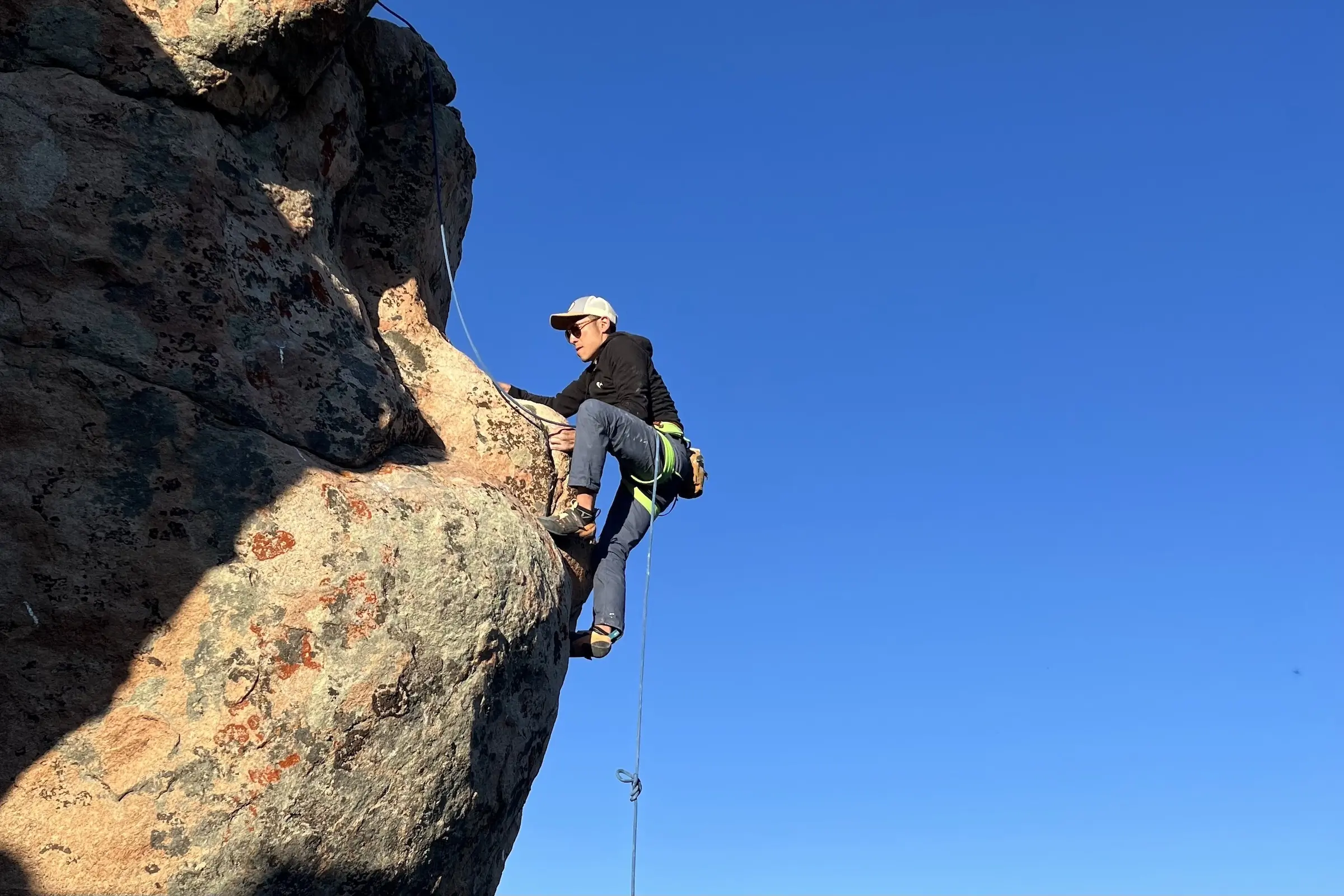
Features
There are a few key features we feel all good climbing pants should have: secure pockets, an adjustable waistband, and a gusseted crotch. Practical, purpose-built features are the difference between climbing-specific pants and all other options. On this list, we’ve included lots of great pants, and each pair offers a unique set of thoughtful features.
Adjustable Waistband
Wearing a belt with a climbing harness is uncomfortable and inconvenient. Instead, look for a pair of climbing pants that includes an integrated system for adjusting the waistband. If you choose a pair of pants that do not have integrated waist adjustment, there are some great, low-profile, active belts on the market that are worthy of consideration.
On this list, we’ve included pants with various styles of adjustment systems. Of these, the classic drawstring is probably our least favorite, as these tend to loosen easily on their own. We love the adjustment system of the Arc’teryx Gamma Pant, which use a super-secure piece of low-profile webbing to tighten or loosen the waist.
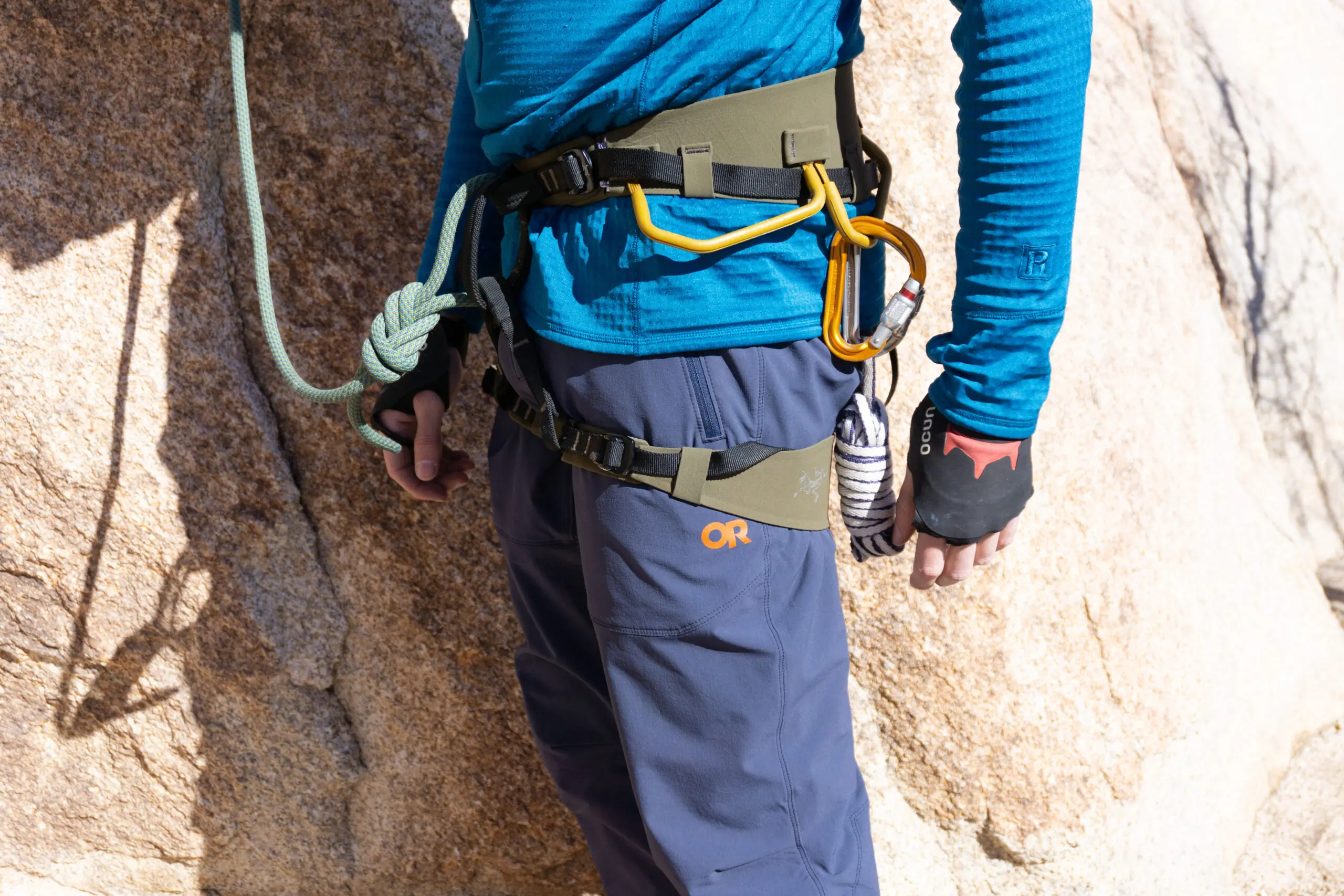



Drawstring Ankle Cuffs
Many climbing pants feature drawstring ankle cuffs — a simple feature that adds some extra utility. Tightening the cuffs of your pants can keep any excess material out of the way while climbing and hiking.
As an extra bonus, this feature also functions as a safeguard against mosquitoes and ticks. On this list, the Outdoor Research Cirque Lite is a nice lightweight option with drawstring ankle cuffs.
Harness-Compatible Pockets
While wearing a harness, it can be difficult to access traditional pants pockets. Many climbers bring a phone along on multipitch routes, and it can be nice to have an accessible and secure place to keep it.
Many climbing pants include thoughtfully placed zippered pockets where a phone or other essential items can be kept safe while climbing. On this list, we love the zippered pockets of the Arc’teryx Gamma for their easy-to-access zippered thigh pocket. It’s out of the way of harness leg loops and large enough to hold most modern phones.


Price & Value
Budget
Your Climbing pants can be totally functional and inexpensive if you know what to look for. Mobility is the most important aspect of climbing apparel, and our Budget Pick, the Mountain Hardwear Basin Pull-On Pants ($79) have a baggy fit and enough stretch to fit various body types for under $100. They’re synthetic, so they’ll dry quickly and are suitable for every type of climbing that doesn’t involve ice or snow.
The Black Diamond Notion pants are also well-priced, are a nice jogger style, and have a gusseted crotch and articulated knees for mobility. They’re comfortable cotton pants, so they aren’t a good choice for the mountains or exceptionally hot days.
When sticking to a budget, you’re missing out on features like zippered pockets, 4-way stretch fabrics, and more stylish offerings. But if you don’t need those things, you can have functional climbing pants and still have money left over for the gas tank.
Mid-Tier
Spending another $20-40 on a pair of climbing pants gets you a pair of synthetic or poly-cotton blend climbing pants that are durable with four-way stretch and zippered pockets and better suited to multi-pitch climbing. Our top pick, the Patagonia Venga Rock Pants ($109), resides in this category. At a reasonable price, you get a versatile, good-looking pant that performs well in most climbing disciplines.
If style is more important to you than moisture-wicking fabrics, the Topo Designs Dirt 5-Pocket Pants ($109) and the Coalatree Decaf Denim Jeans ($109) are rugged and comfortable, and you can seamlessly move from the crag to the bar without looking like a total climbing nerd. You also get to support sustainably sourced materials and Eco-friendly manufacturing methods offered by both brands
Premium
The most expensive climbing pants are designed for use in Alpine environments. They need to be durable but also light and breathable. In this tier, the $200 Arc’teryx Gamma Pants reign supreme with a durable, stretchy nylon that has a thicker weave than the other synthetic pants in our guide. They’re also the only pants in the guide we recommend for ice climbing.
For $50 less, the capable Black Diamond Alpine Pant is a good choice for sunny summer days in the mountains and has all the bells and whistles of a premium pant: Zippered pockets, 4-way stretch, and a built-in belt.
Think carefully about your needs. If you’re mostly climbing in the gym, bouldering, or cragging, there’s no reason to blow your budget on a pair of top-shelf climbing pants.
Frequently Asked Questions
The best pants for climbing are the ones that meet your needs and are enjoyable to wear. On this list, we’ve included many pairs of our favorite climbing pants of 2025. The best bouldering pants will not be the best for ice climbing. Check out our buyer’s guide to figure out what kind of pants will suit you best.
Climbing pants are just like any other pants, except they’re designed with climbing in mind. Climbing pants tend to have unique features geared toward climbers such as a small pocket for bouldering brush or a zippered thigh pocket to hold a phone while wearing a harness. Additionally, climbing pants are often extra stretchy to allow for increased range of motion and dynamic body movements.
On this list, we’ve included styles that range from $40 to over $150. Excellent options are available throughout this entire range. Higher-end materials and features tend to come with a higher price tag.
On this list, we recommend the Arc’teryx Gamma Pant for ice climbing. These durable softshell pants are stretchy, warm, and well-appointed with lots of ice climbing-specific features.
For instance, on the inside of each ankle, these pants have a patch of burly abrasion-resistant fabric to prevent shredding from crampons. Also, these pants easily open up around each ankle to accommodate ice climbing and mountaineering boots.
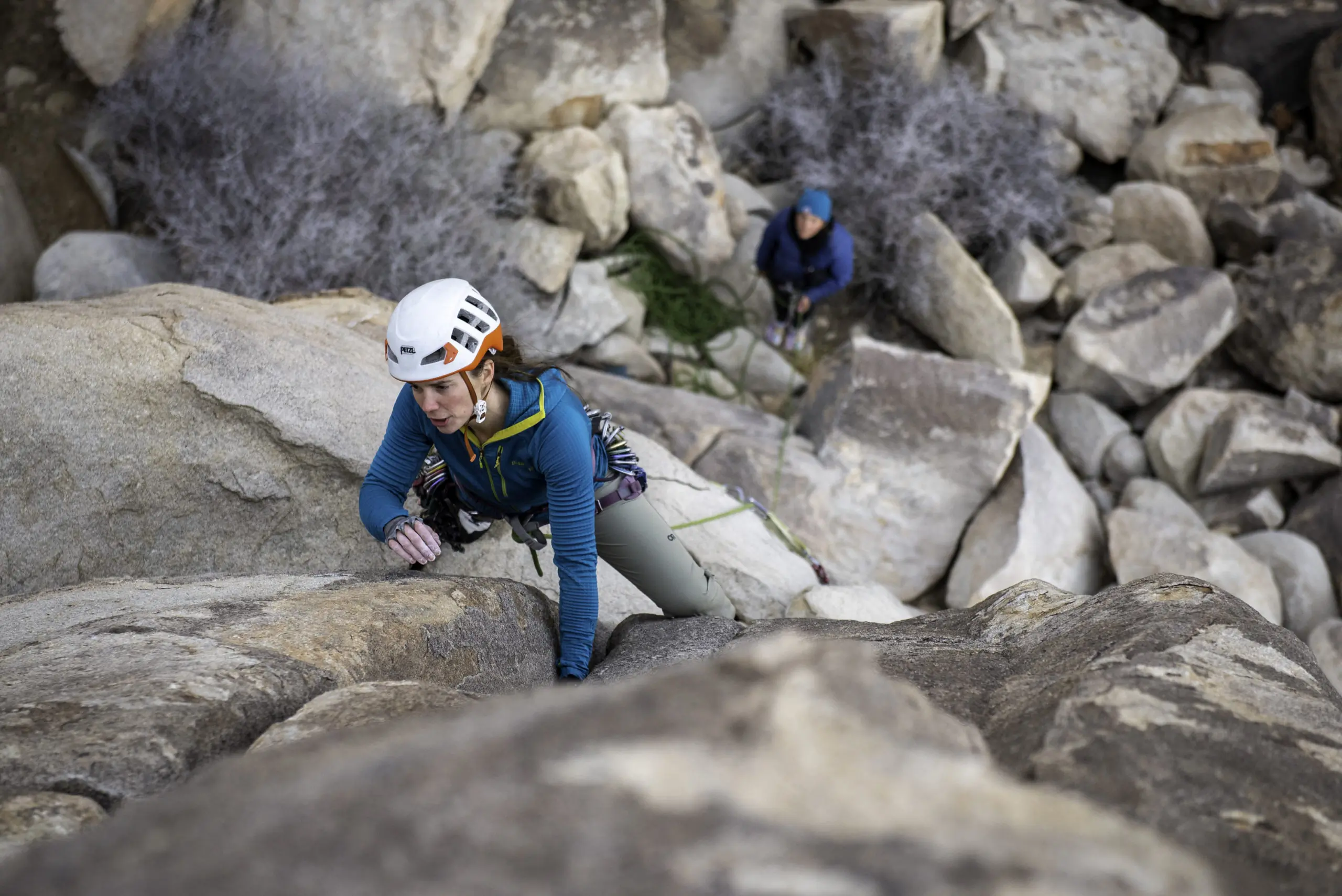

The Best Women’s Climbing Pants of 2025
After months of testing, we found the best women’s climbing pants for every style and budget. Suit up and climb on.


The Best Climbing Harnesses of 2025
We found the best climbing harnesses of 2025. Whether you’re sport climbing or mountaineering, we have you covered.

